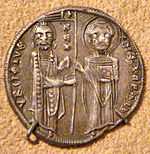Stefan Uroš I of Serbia
| Stefan Uroš I | |
|---|---|
 Stefan Uroš I with his son Dragutin | |
| King of Serbia | |
| Reign | 1243–1276 |
| Coronation | 1243 |
| Predecessor | Stefan Vladislav |
| Successor | Stefan Dragutin |
| Issue |
Stefan Dragutin Stefan Milutin |
| House | Nemanjić dynasty |
| Father | Stefan Nemanjić |
| Mother | Anna Dandolo |
| Born | c. 1223 |
| Died |
May 1, 1277 (aged 55) Sopoćani monastery |
| Religion | Serbian Orthodox |
| Signature |
 |
Stefan Uroš I (Serbian: Стефан Урош I[a]; ca. 1223 – May 1, 1277), known as Uroš the Great[1] was the King of Serbia from 1243 to 1276, succeeding his half-brother Stefan Vladislav. His full style and title was King in Christ, God faithful, King of Serbia and Maritime Lands.
Origin and early life
Stefan Uroš was the youngest son of Stefan the First-Crowned and Anna, the granddaughter of Enrico Dandolo, Doge of Venice.
Succession
In spring 1243 the Serbs rebelled and deposed their King Stefan Vladislav I of Serbia, replacing him with his younger brother Stefan Uroš I. The new king remained on good terms with his predecessor, who is mentioned in some of his charters.
The reign of Stefan Uroš I coincided with the decline of Serbia's primary rivals in the Balkans, Epirus and Bulgaria. This helped Serbia become an influential local power. That development was actively fostered by its king, who encouraged rapid economic development.
Economic development
Saxon miners from Hungary were introduced to work and develop the Serbian silver mines at Brskovo and Rudnik. The Saxon communities were allowed a level of self-government and the right to worship in Catholic-rite churches.
Economic prosperity was also fostered by the related intensification of trade with the Dalmatian cities of Dubrovnik and Kotor. The increase in the mining of silver and in trade naturally led to the introduction of larger quantities of royal coinage, modeled after the Venetian standard.
War with Ragusa
In 1252–1253, Uroš I was at war with the Republic of Ragusa, which bordered the Hum, which was held by his kinsman Radoslav Andrijić. Radoslav swore to fight Ragusa as long as it was in conflict with Serbia, at the same time boasting relations with Béla IV of Hungary. Ragusa took up an alliance with Bulgaria. Peace was ensured in a charter dated May 22, 1254, and the crisis ended.
During the second half of the 1260s a new war broke out with Ragusa, which was secretly favored by the Serbian queen. A treaty was signed in 1268, specifying the amount of protection money that Dubrovnik was expected to supply annually to the Serbian king. The arrangement remained largely unbroken for the next century.
War with Hungary

In 1268 the Serbian king invaded the Hungarian possessions south of the Danube in Mačva, what is now western central Serbia. In spite of some initial success, Stefan Uroš was captured by the Hungarians and forced to purchase his release. A peace treaty was signed between the two kingdoms, and Stefan Uroš's son Stefan Dragutin of Serbia was married to Catherine, the daughter of the future king Stephen V of Hungary.
Later years
By the end of his reign, Stefan Uroš apparently succeeded in suppressing the autonomy of Zahumlje, where the local princes became virtually indistinguishable from the rest of the nobility. In his effort to achieve centralization, the king appears to have alienated his eldest son by refusing to grant him an appanage. The conflict between father and son exacerbated, and the king apparently considered making his younger son, the future Stefan Milutin, his heir.
Worried about the inheritance and his very life, Stefan Dragutin finally demanded to be associated on the throne in 1276. When Stefan Uroš refused, Dragutin rebelled and received help from his Hungarian relatives. The allies defeated the Serbian king and Stefan Uroš was forced to abdicate and retire to an unidentified monastery in Hum where he died a year or two later. His remains were later moved to his monastic foundation of Sopoćani.
Endowments
-

Sopoćani Monastery
Family
| Wikimedia Commons has media related to Stefan Uroš I. |
By his wife Helen, who was either an Angevin princess or a daughter of the Latin Emperor of Constantinople, Stefan Uroš I had at least three sons:
- Stefan Dragutin, who succeeded as king
- Stefan Milutin, who succeeded as king in 1282
- Brnjača, a daughter
| Ancestors of Stefan Uroš I of Serbia | ||||||||||||||||||||||||||||||||||||||||||||||||||||||||||||||||||||||||||||||||||||||||||||||||||||||||||||||||||||||||||||||||||||||||||||||||||||||||||||||||||||||||||||||||||||||||||||||||||||||||||||||||||||||||||||||||||||||||||||||||||||||
|---|---|---|---|---|---|---|---|---|---|---|---|---|---|---|---|---|---|---|---|---|---|---|---|---|---|---|---|---|---|---|---|---|---|---|---|---|---|---|---|---|---|---|---|---|---|---|---|---|---|---|---|---|---|---|---|---|---|---|---|---|---|---|---|---|---|---|---|---|---|---|---|---|---|---|---|---|---|---|---|---|---|---|---|---|---|---|---|---|---|---|---|---|---|---|---|---|---|---|---|---|---|---|---|---|---|---|---|---|---|---|---|---|---|---|---|---|---|---|---|---|---|---|---|---|---|---|---|---|---|---|---|---|---|---|---|---|---|---|---|---|---|---|---|---|---|---|---|---|---|---|---|---|---|---|---|---|---|---|---|---|---|---|---|---|---|---|---|---|---|---|---|---|---|---|---|---|---|---|---|---|---|---|---|---|---|---|---|---|---|---|---|---|---|---|---|---|---|---|---|---|---|---|---|---|---|---|---|---|---|---|---|---|---|---|---|---|---|---|---|---|---|---|---|---|---|---|---|---|---|---|---|---|---|---|---|---|---|---|---|---|---|---|---|---|---|---|
| ||||||||||||||||||||||||||||||||||||||||||||||||||||||||||||||||||||||||||||||||||||||||||||||||||||||||||||||||||||||||||||||||||||||||||||||||||||||||||||||||||||||||||||||||||||||||||||||||||||||||||||||||||||||||||||||||||||||||||||||||||||||
| Stefan Uroš I of Serbia Born: 1223 Died: 1 May 1277 | ||
| Regnal titles | ||
|---|---|---|
| Preceded by Stefan Vladislav |
King of Serbia 1243–1276 |
Succeeded by Stefan Dragutin |
| Preceded by Stefan Vladislav and Beloslava of Bulgaria |
King of Zeta 1267–1276 |
Succeeded by Helen of Anjou |
Annotations
- ^ Name: Stefan Uroš I in English. He is called "Stefan the Great" (Стефан Велики), or "Uroš the Great" (Урош Велики). He is also called Uroš Hrapavi (Урош Храпави) or Stefan Hrapavi (Стефан Храпави), hrapavi means "rugged" or "rough".
References
- ↑ Jireček 1967, p. 310: "König Stephan Uros" I. (1243 — 1276) wird von den Männern der serbischen Kirche, von Domentian und Daniel, der „Große" (veliki) genannt,"
Sources
- Fajfrić, Željko (2000) [1998], Sveta loza Stefana Nemanje, Belgrade: Tehnologije, izdavastvo, agencija Janus
- Fine, John Van Antwerp (1994), The Late Medieval Balkans: A Critical Survey from the Late Twelfth Century to the Ottoman Conquest, University of Michigan Press, ISBN 978-0-472-08260-5
| ||||||||||||||||||||||||||||||||||||||
| ||||||||||||||||||||||||||
